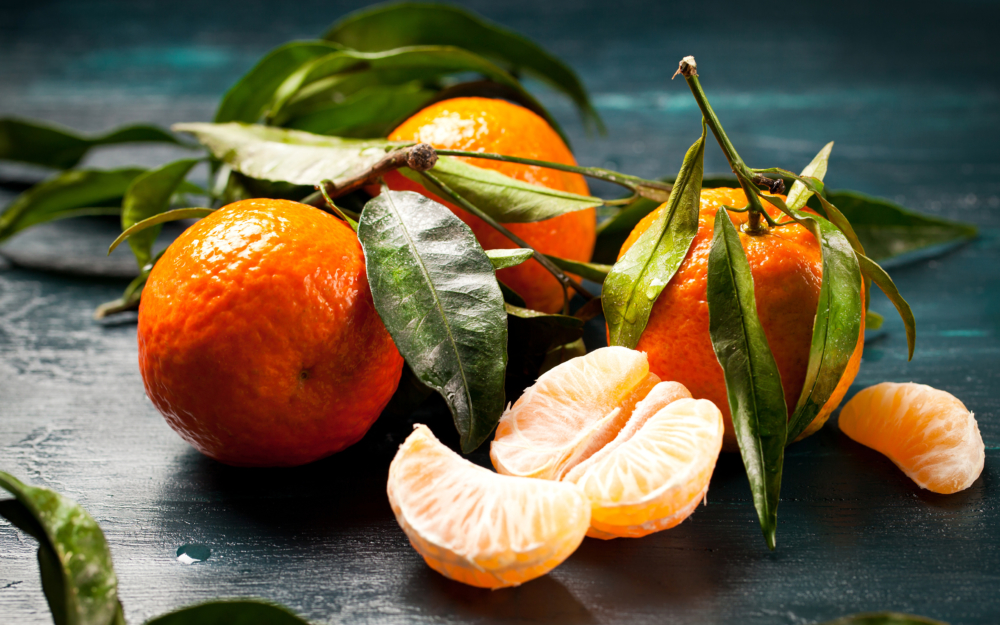There is probably no such person who would not be reminded of tangerines about the New Year holidays. Eating a delicious fruit, almost no one thinks about its benefits, chemical composition, and even more about how many calories are in tangerine. Few people know that China is considered the birthplace of citrus, but now it can be found in almost any country. Thanks to this, the fruit can hardly be called exotic.
Material Content:
Chemical composition and nutritional value
Like other citrus fruits, mandarin contains a large amount of vitamin C. This component not only strengthens the immune system, but also accelerates wound healing, and also serves as an excellent prevention of the oral cavity from inflammatory processes.
88% of citrus fruits are water. Dietary fiber accounts for 1.9%, protein - 0.8%, fat - 0.2%, carbohydrates - 7.5%.
Specialists noted a large number of flavonoids in mandarin. They eliminate free radicals that rid the body of slagging. Vitamin B1 is responsible for metabolic processes, helps rejuvenate the body and restore cells.
It is also worth mentioning that the composition of the fruits includes:
- vitamins of group A;
- cellulose;
- vitamin P;
- organic acids;
- mineral salts;
- pectin;
- glycosides;
- volatile production.
How many calories in tangerine
When planning to consume citrus, do not forget that it contains components such as sucrose, glucose and fructose. Despite this, the calorie content of mandarin is not so high. To date, specialists have developed a special mandarin diet, with which you can slightly reduce their weight.
Please note that the diet, which is based on tangerines, is not for everyone. Citrus is considered a powerful allergen and often causes allergic reactions.
The calorie content of the fruit directly depends on how it is consumed:
- Fresh tangerines. There are 33 kcal per 100 grams of product. On average 1 pc. fruit weighs from 30 to 100 grams, therefore, the number of calories consumed will vary from 12 to 38 units. During the processing of citrus, a large amount of energy is spent in the body, as a result of which the number of calories obtained will have a negative indicator. Please note that the energy value indicated is tangerine with peel.
- Dried tangerines. During the drying process, the fruits become sweeter, which leads to an increase in calorie levels. In 100 grams of the product, about 230 kcal. Such a product is not suitable for diet food.
- Freshly squeezed tangerine juice - only pulp is used for cooking. Its calorie content is practically no different from fresh fruits. 100 g of product contains 38 kcal.
The content of vitamins and minerals
Mandarin contains 6 essential vitamins that have a positive effect on the health of the body:
- Ascorbic acid - an assistant to our immunity, is a good prevention of respiratory diseases, has a positive effect on the skin condition, and reduces the risk of developing diseases of the cardiovascular system.
- Vitamins of group B - they have many useful properties, including active participation in metabolic processes, influence on the functioning of the nervous system, stimulation of the gastrointestinal tract.
- Retinol - prevention of diseases of the organs of vision.
- Phylloquinone - improves blood coagulation, helps form bone tissue.
- Calciferol - participates in metabolic processes between minerals, primarily phosphorus and calcium.
- Tocopherol - affects cholesterol, takes part in tissue regeneration.
The benefits of fruit for the body
It's no secret that tangerines are rich in vitamin C. An average of 1 pc. contains about 42% of this component, which helps to strengthen the immune system. Vitamin A is necessary for redox processes, in addition, it contributes to the absorption of iron. Other useful properties include:
- A positive effect on the digestive system. The fruit not only speeds up metabolic processes, but also eliminates dysentery.
- One of the important properties of mandarin is antibacterial, which makes its juice an excellent tool for the treatment of skin diseases.
- Citrus has hemostatic properties.
- From dried zest you can make tea, which is famous for its sedative properties.
- With the help of a tangerine decoction, inhalations can be made, which are extremely necessary during respiratory diseases.
If you regularly use tangerines, this helps:
- quenching thirst, especially during fever;
- prevention of diseases of the cardiovascular system;
- lower cholesterol;
- regulation of insulin levels.
Today, mandarin is one of the most affordable fruits. Despite the fact that the peak season is in the winter months, fruits can be purchased at almost any time of the year.














